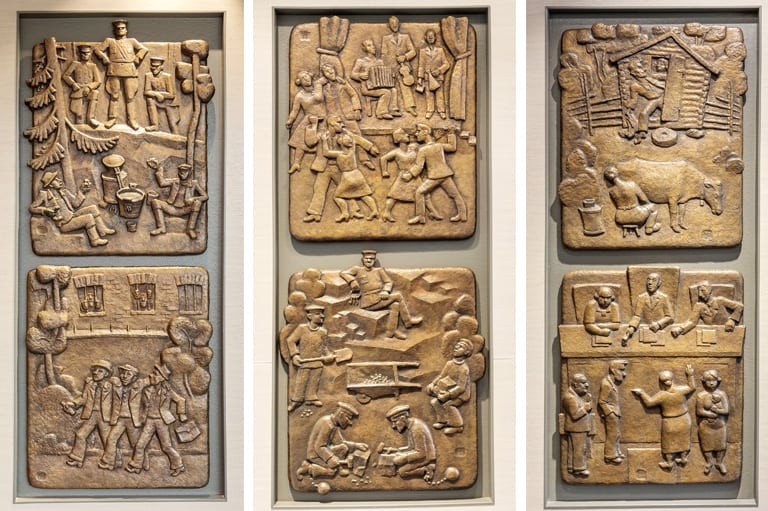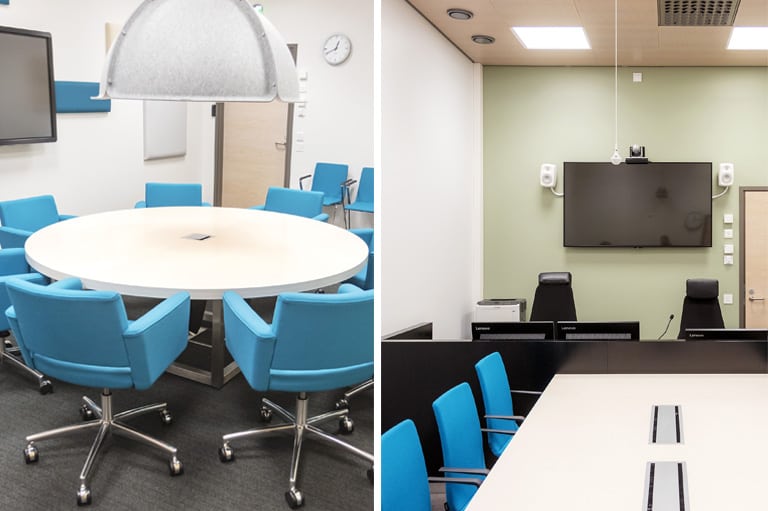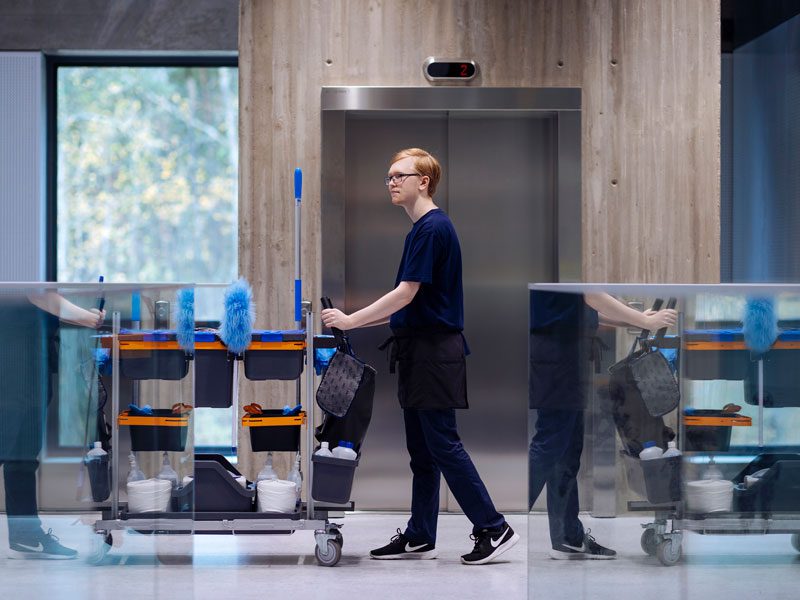All visitors entering the red-walled entrance of the Joensuu courthouse and police station will be greeted by security personnel, pass through a metal-detector gate and their bags will be x-rayed.
According to Tuija Turpeinen, Chief Judge of the district court, security is one of the foundations of the new building.
“Having a security inspection is a huge change. In the previous premises, anyone could just walk in, which seems very odd now,” Turpeinen says.
The two other words are health and technology. There were serious indoor air problems in the previous courthouse and police station, located in the centre of Joensuu and completed in 1983, and the building was completely demolished. According to Markku Inkeroinen, who is a Construction Project Manager at Senate, this time indoor conditions were taken into account at every stage of the construction of the new building.
“For instance, the moisture of concrete was continuously measured to ensure that it was dry before it was overlaid.”
Inkeroinen says that the Joensuu courthouse and police station has been one of Senate’s priority projects, which means it was important in many ways. After all, Senate rarely constructs new buildings nowadays. The total cost of the Joensuu project exceeded 30 million euros.

Tuija Turpeinen, Chief Judge, was involved in the planning of the construction project first as a District Court staff member and from 2016 as the head of the court. “Work development has always interested me. Now is a good time to help the court system to adopt electronic tools.”
Important for the entire province
The new courthouse and police station is important for the whole of North Karelia Province. Tuija Turpeinen says that the plan is to reduce the number of district courts from 27 to 20 and, at one point, concentrating all operations in eastern Finland in Kuopio was on the table, which would have removed Joensuu from the court map as an independent operator.
“A combined Eastern Finland district court would have been a huge unit both geographically and by case load. We are extremely happy that the District Court remained in Joensuu as an independent court and that we now have new premises. While video can be used in court cases more and more often, you cannot try cases solely via Skype. As a general rule, the people needed to try a case have to be in the same place, which has increased costs because people have to travel further.”
According to Turpeinen, the fact that the unit in Joensuu will continue has a strong impact on the vitality of the region.
“When the district court was discontinued in Nurmes in 2010 with only a court room remaining, it had an impact on law firms. As a result, there were fewer legal services available in Nurmes and they were further away.”
The new building has attracted interest in Karelia even beyond court and police customers. During the three-hour open house organised in October 2017, more than 300 people attended the event. According to Turpeinen, so many people have asked about a new opportunity to visit that another open house event will be organised in autumn 2018.

The Joensuu courthouse and police station was completed in autumn 2017. Thanks to its location outside the city centre in the Pakala district, there is ample parking space for customers.
Five organisations under one roof
The Joensuu courthouse and police station was built in accordance with a national model for court and police buildings. In total, roughly 300 people work in the building and, in addition to the North Karelia District Court, the Eastern Finland prosecutors office, Eastern Finland Police Department, the National Bureau of Investigation and the Finnish Security Intelligence Service are also housed in it.
The North-Karelia-red entrance and the security inspection are shared by all of them, but the police and customer service premises are to the left of the lobby and the District Court and its lobbies and courtrooms are to the right. There is a café and restaurant downstairs that is open to staff and customers.
“The restaurant is a great addition for the customers visiting the building. Now they don’t have to leave and go somewhere else to eat when they’re attending a court case. It’s a couple of kilometres from Pekkala to the centre of Joensuu so a trip there for something to eat takes time,” says Turpeinen.

In the large court room of the District Court, all parties to a trial have their own screen. To the left, behind a glass wall there is a separate room for witnesses who fear for their safety, into which you cannot see from the court room. The voice of a witness giving testimony from this room can also be altered so that it cannot be recognised. When in the role of a judge, Tuija Turpeinen sits at the front of the court room with the secretaries, clerks and the lay members of the court.
Advanced courtrooms
The project plan for the Joensuu courthouse and police station was made in 2012, after which its actual design was started. Construction was started in 2015 and the building was inaugurated in autumn 2017.
“The project stage took a little longer than normal because the building has several users, each with their own decision-making organisation, and it also took time to identify a solution that fit the budget,” says Markku Inkeroinen, Construction Project Manager.
The project steering group included members from Senate and the users as well. Tuija Turpeinen represented the District Court from the beginning.
Work development has always interested me. One thing about my work that motivates me is that I can influence how I work, and new and modern premises also play a role in it.
Turpeinen says Joensuu is a pilot project and the experiences gained there will be used in the modernisation of district courts in other cities. For instance, the Lappeenranta court has visited North Karelia to find out how the wireless network, ceiling microphones and interactive screens work in the court and other rooms.
“Our court rooms are very advanced in terms of digital technology. Earlier, large piles of paper moved back and forth between the secretary and judge during trials but with the electronic system, documents are much easier to manage. Now I have two screens on my judge’s desk and I can use one of them to make notes and work on documents even during a trial.”
The largest court room seats 70 people, with 30 seats reserved for the parties of a case, 20 for the public and the rest for the district court judges, secretaries, clerks and lay members.
“Every party also has their own screen. This has had a clear impact on their alertness. Earlier, people sometimes nodded off during a trial but now they seem to follow what material is being examined at a given time.”
According to Turpeinen, especially younger lawyers have welcomed the digital reform and quickly learned how to use the tools. At the District Court, lawyers also have their own room and they are provided with access cards so that they can access meeting rooms when they need to.
“The digital systems have also made lawyers’ work easier. In the past, they often had a briefcase full of documents to carry around but now all they need is their laptop.”


The District Court lobby is remarkably light and its interior is beautifully blue-toned (photo at top).
Raimo Heino’s reliefs from 1983 adorn the doors to the court rooms. The works, entitled Crime and Punishment, Moonshine and Child Support depict human fallibility, court proceedings and punishments (photo at bottom).
Broad-based feedback seminar
According to Markku Inkeroinen, the Joensuu project met its key targets: schedule, budget and quality of construction.
“Obviously there is always something that could have been done better but there were no major surprises. What made the difference was that all users were actively represented as early as at the planning stage, tours of the site were organised for them during construction and we also held regular meetings together. This enabled us to take the users’ wishes into account from the start.”
Tuija Turpeinen agrees that it was important that the various users could explain their needs to the building’s designers from the start.
“Sometimes we had to talk them carefully through to explain what we needed regarding access to court rooms: how staff move from one place to another, how detainees are brought to the rooms so that they won’t encounter anyone else and where the doors are. We went through all this in great detail because it is not only about efficiency but also about security.”
Turpeinen praises the cooperation of the planning stage. There was some trouble towards the end of the construction stage.
“We didn’t have enough time when we moved. The summer of 2017 was very hectic, as the new building was still being finalised while we had to empty our old location and it was hard to keep everyone informed.”
During the past year various issues have emerged, including a court room door that has not always closed properly. Commissioning meetings will be held once a month for now.
“The meetings provide information and we learn how repair work is progressing.
In late June 2018, all parties involved held a broad-based feedback seminar. Markku Inkeroinen says that the entire project from planning-stage cooperation to the current situation, a year after commissioning, was analysed.
“What we learned from the feedback was that we should have reserved more time to test building engineering and other technology and for any repairs. On the positive side, the construction site was very tidy throughout the project and there were very few accidents. All in all, the users said they are very satisfied with the functioning of the building’s various facilities,” says Inkeroinen.

The District Court has a total of seven courtrooms, of which two are small preparation rooms seating only a few people (photo on the right). Instead of individual microphones, they have microphones in the ceiling. In the conciliation room (photo on the left) there is a funny lamp above a round table which often turns into an icebreaker.
Saved space and harmony
Now the District Court has a little over 17 square metres per person-work-year whereas in the old premises the figure was well over 20. According to Turpeinen, moving into an activity-based environment raised concerns before and after commissioning.
“Our premises at the District Court are of a hybrid type which means that some of the staff work in an activity-based environment but the judges still have their own rooms. A lot of our phone calls are confidential and we cannot conduct them in an open office. For example, process servers must be able to answer their phone immediately when a person they are trying to reach calls. You can’t just tell them to wait a minute, I’ll get my things and move to a better place, because that might be the end of the call.”
Turpeinen says that the staff have become so accustomed to the premises and the new electronic tools during the past year that they have got over their initial shock.
“People are quite satisfied now. We spent eight long years in temporary premises in another part of Joensuu and what’s best about the present situation is that all users are now in the same building. The premises work very well together; everything is harmonious and well coordinated.”
In 2017, the North Karelia District Court processed more than 14 000 cases, of which criminal cases numbered around 1 400, and disputes and applications, including child custody cases, amounted to around 1 000.
Turpeinen is very happy with the conciliation room of the new building, with seats around a round table, a fun lamp above it and, on the wall, colourful acoustic panels and Piia Lehti’s art work Tree of Life.
“We’ve never had a room like this. It is very different sitting around a round table trying to find a compromise from being in an ordinary preparation room where even the table underscores the confrontation. Everyone has been happy with the conciliation room. The impressive lampshade is a great icebreaker.”

















